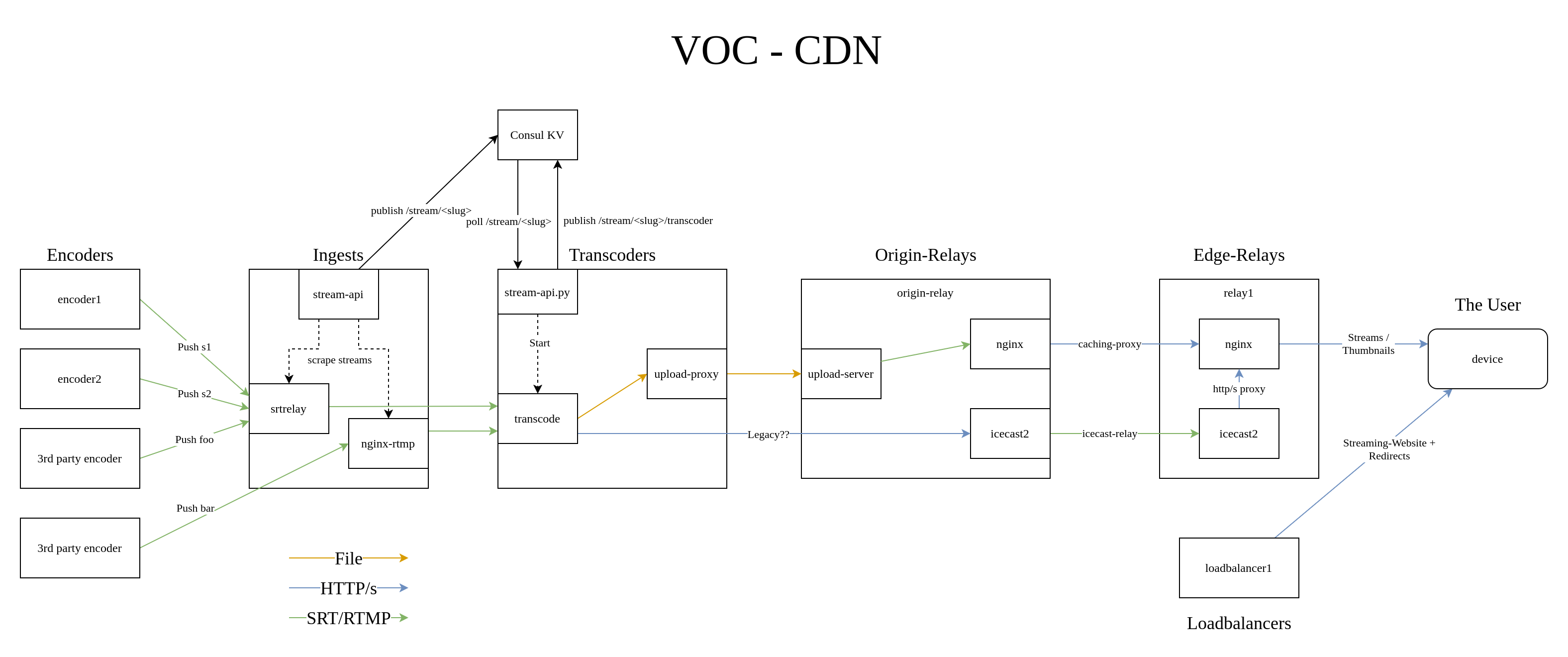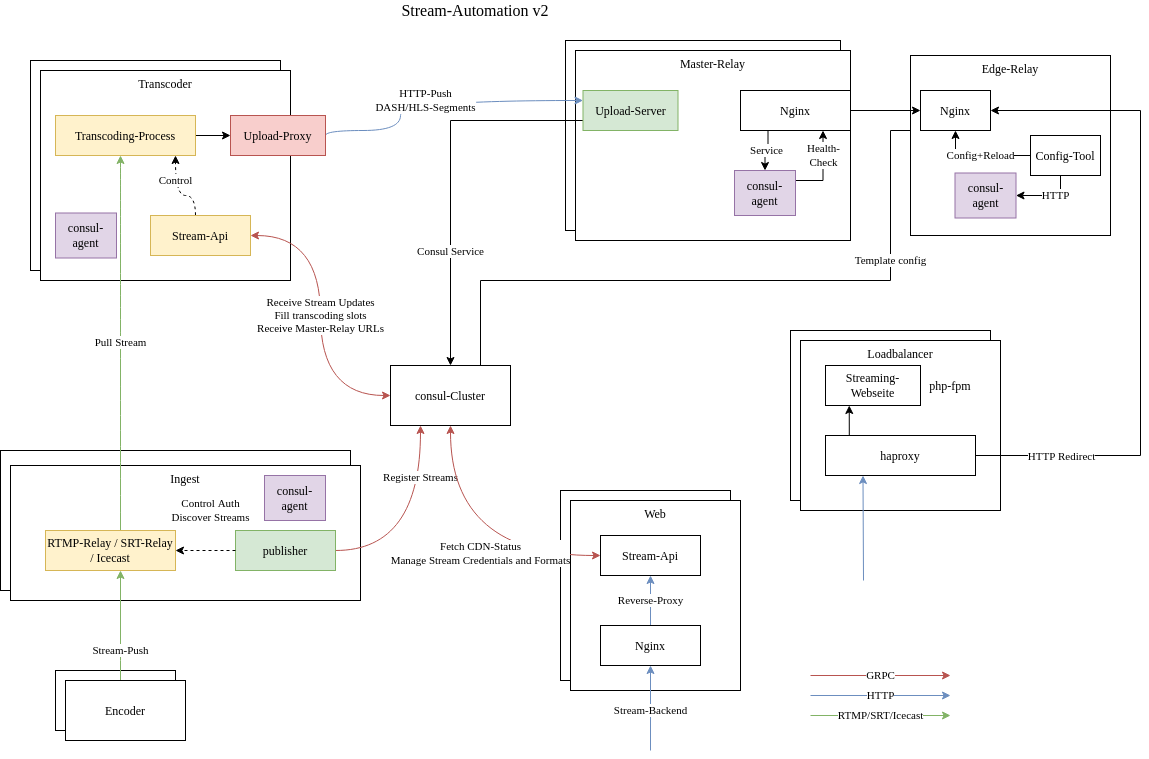CDN
Note: This documentation describes our Livestreaming CDN as of 2025.
The File-CDN for media.ccc.de is described on Voctoweb.
Repo Links
- Stream-api, Upload-Proxy, Upload-Server: https://github.com/voc/stream-api
- rtmp-auth daemon: https://github.com/voc/rtmp-auth
- Transcoding-Script: https://github.com/voc/transcoding
Architecture
The CDN-Cascade has 6 stages: Encoder, Ingest, Transcoder, Origin-Relays, Edge-Relays and finally Load-balancers. 
1. Encoder
The initial stream encoding is created near the stage on the encoder PC running voctomix or any video-encoder for third party streams. The encoding usually contains a 1080p25 H264 video signal, the slides as 1080p5 and up to 3 tracks of audio encoded in AAC (Native, Translated, Translated-2). The translated audio tracks and the slide video track are optional.
The origin encoding is pushed as MPEG-TS via SRT to the ingest stage.
2. Ingest
The ingest machines run both srtrelay and nginx-rtmp to receive pushed streams from the encoders. This also serves as the entry point for third party streams.
Additionally the ingest machines run a stream-api daemon which scrapes the local stream information from both srtrelay and nginx-rtmp and publishes it to consul KV. The consul KV path is /stream/<stream slug>
# consul kv get /stream/s96
{"format":"mpegts","source":"srt://ingest.c3voc.de:1337?streamid=play/s96","slug":"s96","publishedAt":0}
3. Transcoder
The stream transcoding transforms the mpegts stream into multiple segmented streams (one per quality) via one big ffmpeg script. Additionally it creates thumbnails and preview images. The transcoding script can be found here https://github.com/voc/transcoding.
A python script runs constantly on each transcoder which fetches streams from consul and tries to claim streams which don't have a transcoder assigned yet. The consul KV path is /stream/<stream slug>/transcoder
# consul kv get /stream/s96/transcoder myloc-transcoder3 # To reallocate a transcoder for a stuck stream consul kv delete /stream/s96/transcoder
Every time a transcoder claims a stream it writes an env file and starts a systemd unit to run the transcoding script. The transcode updates are also published to the #voc-wok IRC.
The transcoding outputs are directly pushed with HTTP uploads to the Origin relays. To ensure proper retries the uploads are sent over a local http-proxy (https://github.com/voc/stream-api/tree/master/cmd/upload-proxy).
4. Origin Relays
Origin relays run the upload server (https://github.com/voc/stream-api/tree/master/cmd/upload-server) which receives the http uploads and stores the files on local disk. The upload server has some additional logic to rewrite the HLS playlists on the fly in order to properly handle stream restarts.
The segmented streams, thumbnails etc. are currently served by nginx.
5. Edge-Relays
The edge relays run nginx with caching proxy config and upstream set to the active origin relay.
6. Loadbalancer
The end-user facing domains streaming.media.ccc.de as well as cdn.c3voc.de are served by the load-balancers using DNS round robin.
streaming.media.ccc.de
The load-balancers serve the Streaming-Webseite under this domain. The sites run completely independent and are just kept in sync by the deployment script. With this procedure one or more load-balancers can easily be taken out of the DNS rotation if necessary.
cdn.c3voc.de
Requests to cdn.c3voc.de are handled by haproxy on the load-balancers with redirects to one of the edge relays. The redirects are performed following a preconfigured weight distribution.
The relay weight distribution is stored in consul KV and can be tweaked in real time. The haproxy configs automatically get updated by consul-template after a change.
# Get the current weight distribution, if not explicitly set the default is 100 consul kv get -recurse /services/haproxy/backends/ services/haproxy/backends/live.event.c3voc.de/weight:1 services/haproxy/backends/relive.c3voc.de/weight:1
Because of the behavior of HLS/DASH clients if a client fetches a playlist file and gets a redirect, all further requests go to the same origin. With this trick the clients stay persistently on one relay until they are redirected.
Stream-URLs
The resulting stream URLs are as follows (replace @slug with your actual stream slug):
HLS (H.264 multi-quality + multi-language)
Moar HLS
- http://cdn.c3voc.de/hls/@slug/translated_hd.m3u8 - also multi-language, just a different default language
- http://cdn.c3voc.de/hls/@slug/native_sd.m3u8 - only SD, but still multi-language
Currently not active:
MPEG-DASH (VPx multi-quality + multi-language)
Audio-MP3:
Audio-Opus:
Dynamic SRT/RTMP endpoints with RTMP Auth
SRT and RTMP Endpoints can be created under https://ingest.c3voc.de/backend/ (Password in keepass under ansible/stream-api/htpasswd). After creating the endpoint the stream can be pushed to any ingest machine.
The RTMP-URL for the endpoint stream/qtest23 on ingest1 would be: rtmp://ingest.c3voc.de/stream/qtest23?auth=<token>
The SRT-URL would be : srt://ingest.c3voc.de:1337?streamid=publish/qtest23/<token>
Future improvements
The diagram below shows the envisioned architecture as of 2020. In the meantime many of the improvements have been integrated into the CDN. Some more potential improvements are as follows:
- Dynamically adapting the streaming-website to the existence/lack of a stream
- Building a live status dashboard which shows the current stream→ingest→transcoder pipelines
- To gracefully shutdown a relay it could be instructed via consul KV to redirect all clients back to a load balancer while taking it out of the haproxy redirects. That way all clients would be redistributed to different relays.
- Build origin relay redundancy using dynamic upload client and relay upstream configuration. (Relay upstreams need to be sticky, because the HLS playlists generated on the origin relay are not deterministic)
- Use DNS rotation on ingest
- Finalize srtrelay meshing to allow pushed streams to be pulled from any ingest machine.
